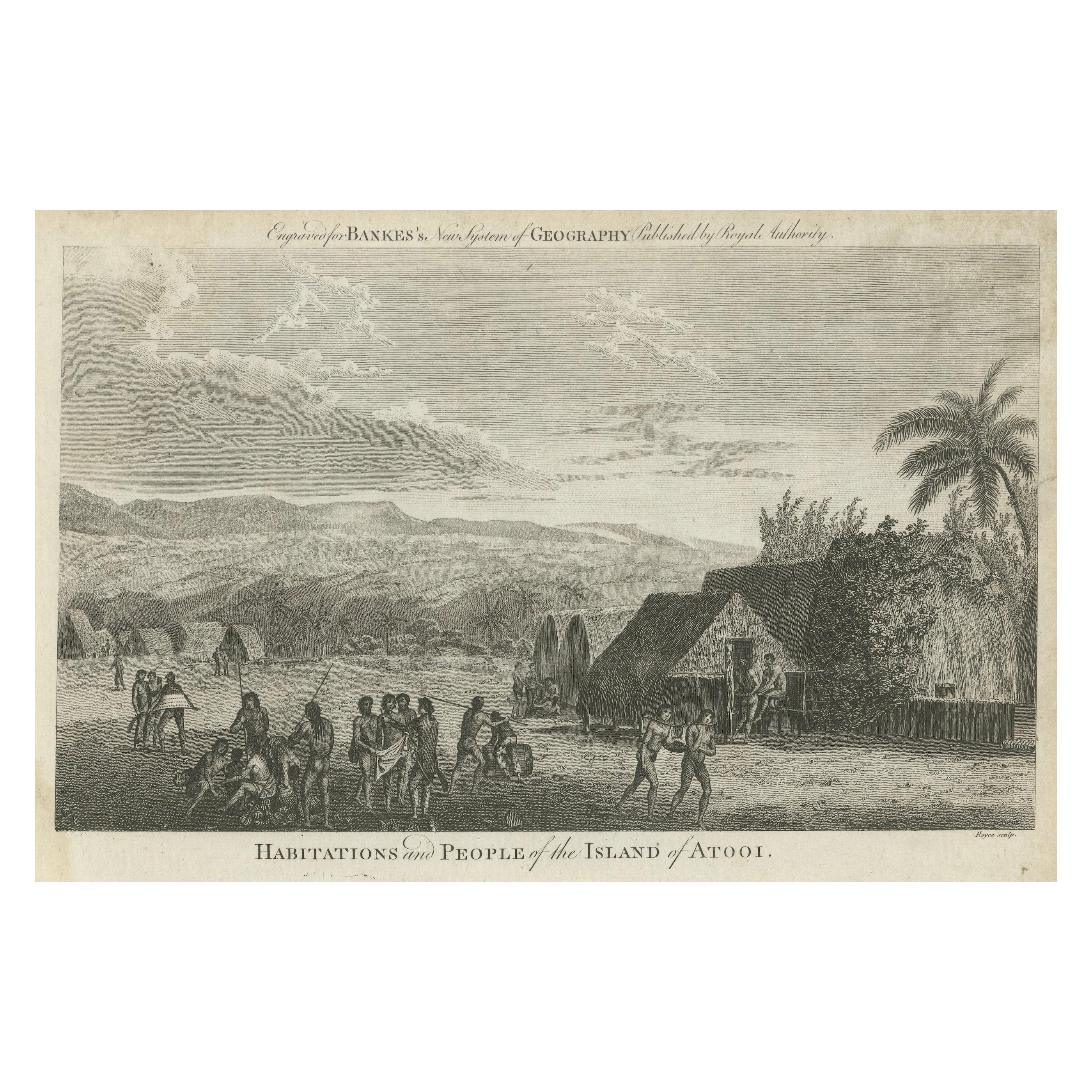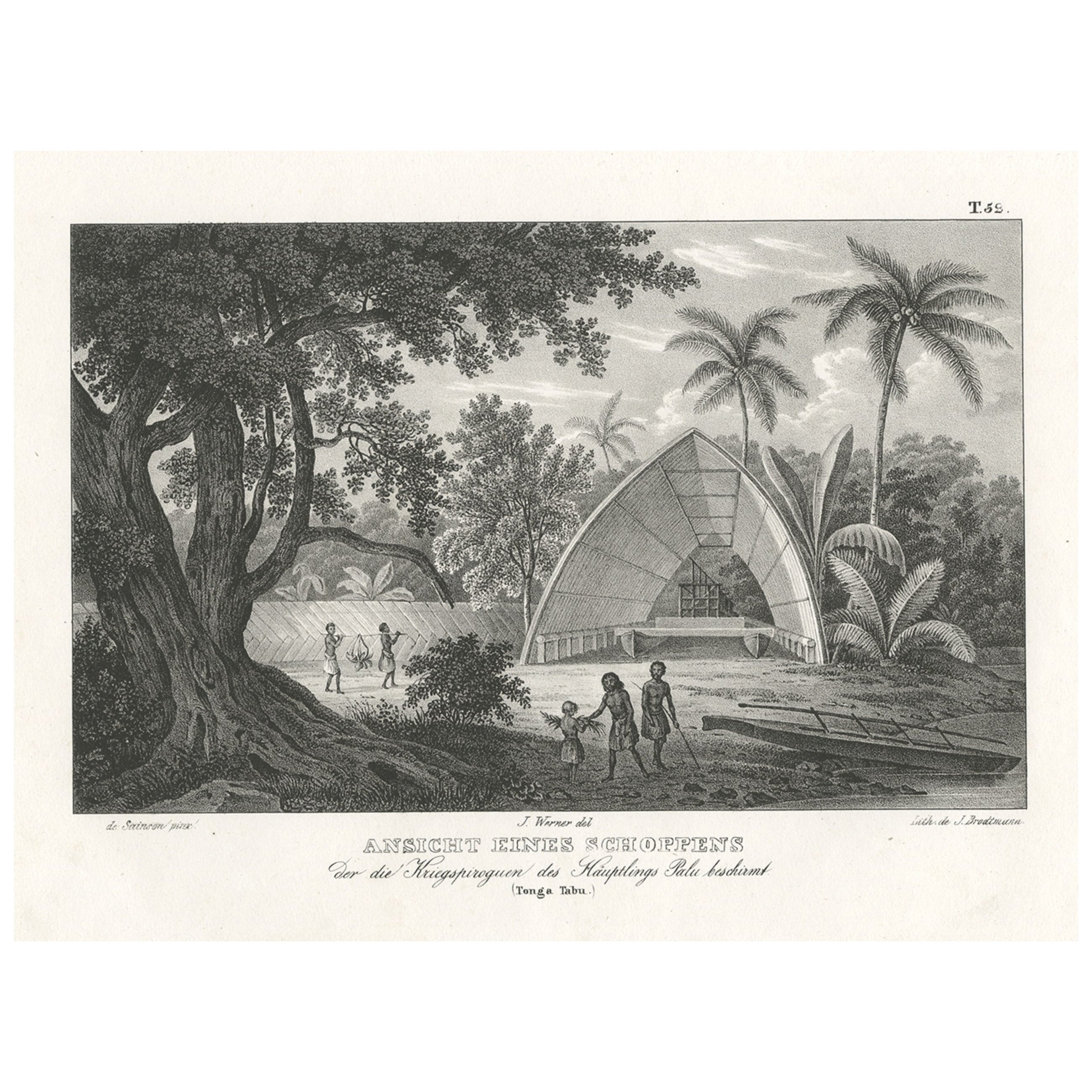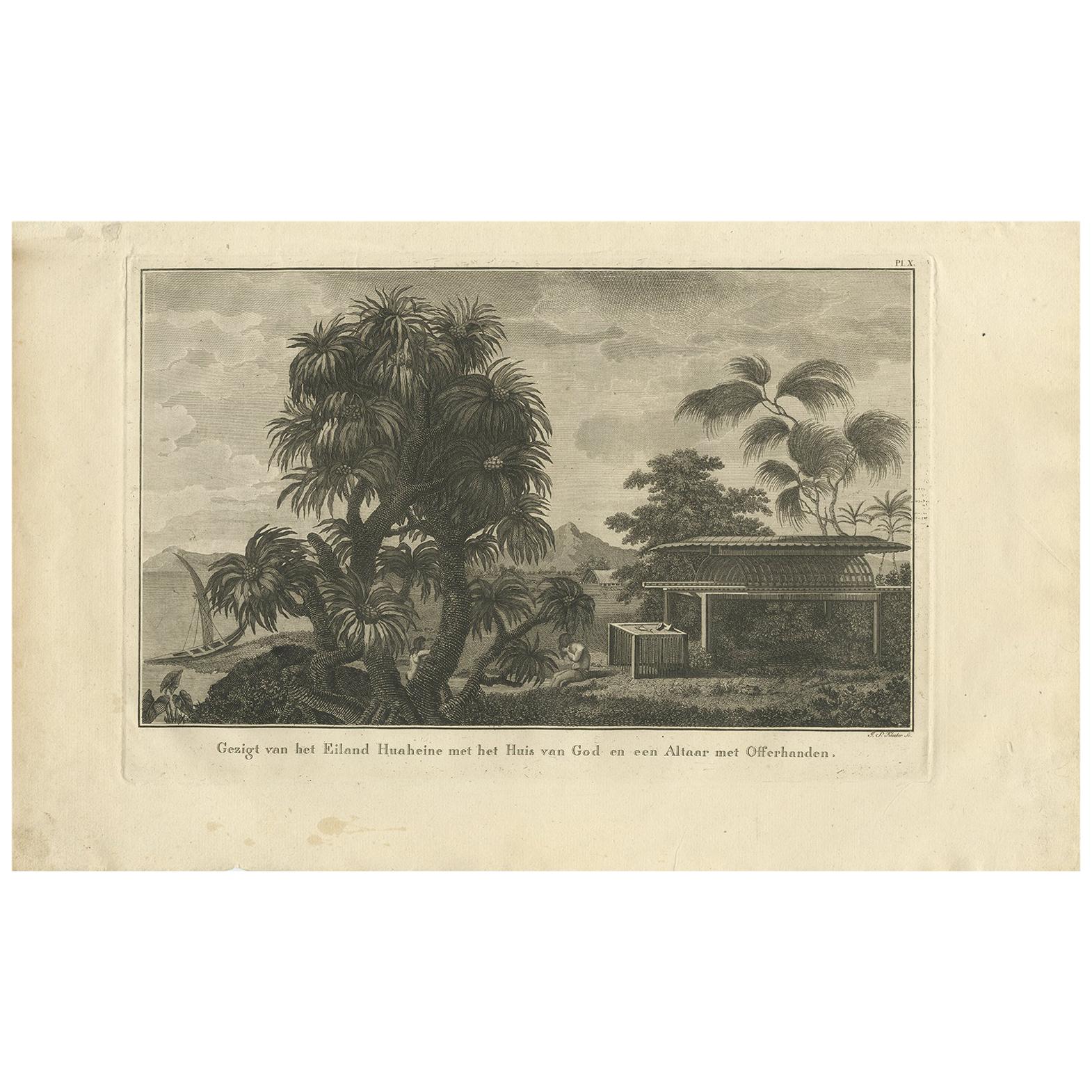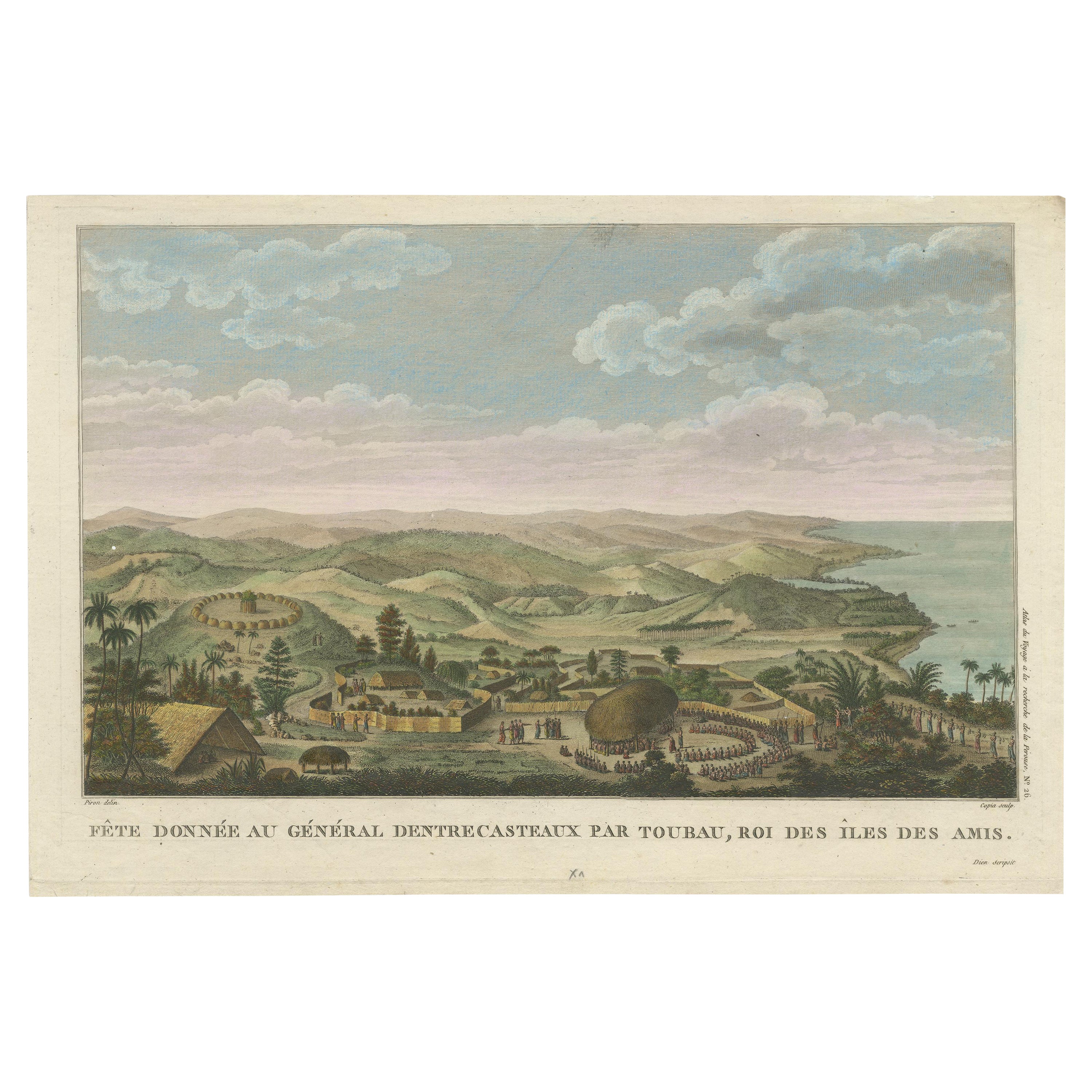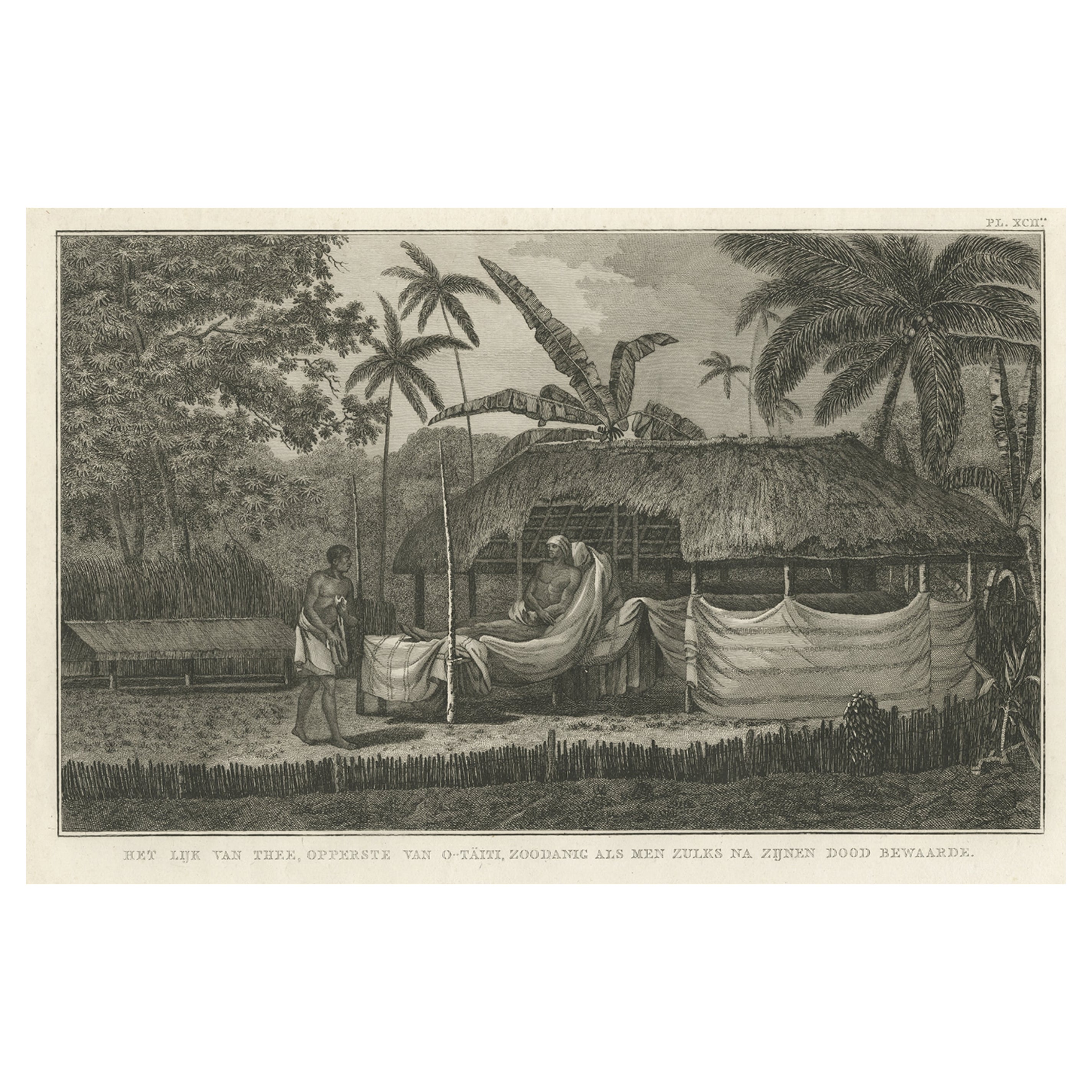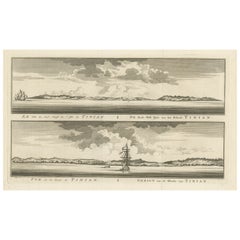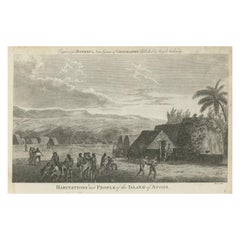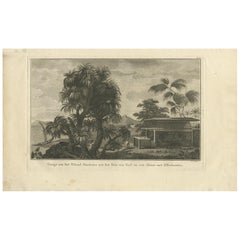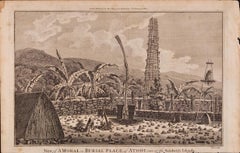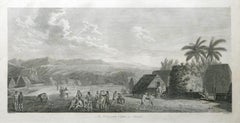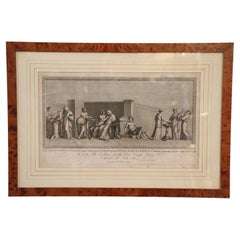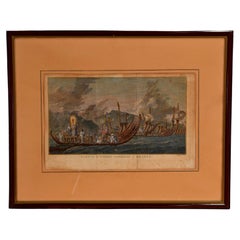Items Similar to 18th-Century Engraving of Hawaiian Morai and House Interior, c. 1780s
Want more images or videos?
Request additional images or videos from the seller
1 of 7
18th-Century Engraving of Hawaiian Morai and House Interior, c. 1780s
$165.40
£123.98
€140
CA$227.24
A$253.69
CHF 132.93
MX$3,105.39
NOK 1,688.19
SEK 1,591.75
DKK 1,065.73
Shipping
Retrieving quote...The 1stDibs Promise:
Authenticity Guarantee,
Money-Back Guarantee,
24-Hour Cancellation
About the Item
This finely executed engraving, titled "The Outside of a Morai, or Burial Place in Atooi" and "The Inside of a House, in the Morai in Atooi," offers a fascinating depiction of Hawaiian (Atooi/Kauai) ceremonial and cultural spaces. Published for 'Bankes’s New System of Geography', this print reflects the growing European interest in the Pacific islands during the late 18th century, influenced by the accounts of Captain James Cook's voyages.
The upper panel portrays a Morai (heiau), an outdoor sacred burial site or temple used by native Hawaiians for religious and ceremonial practices. The structure features towering wooden carvings, possibly *ki‘i* (representations of gods), set against a lush tropical backdrop with banana trees and volcanic peaks. This detailed representation illustrates the European fascination with Polynesian spiritual sites, while also documenting architectural and cultural elements unique to the region.
The lower panel presents the interior of a house within the Morai. The thatched roof and woven mat walls exemplify traditional Hawaiian building techniques. Three figures, likely priests or individuals of importance, stand solemnly before an altar or ceremonial arrangement. The scene highlights the ritualistic significance of such spaces and offers a rare glimpse into Hawaiian customs as perceived by European explorers.
This engraving is notable for its careful detail and cultural value, reflecting the Enlightenment-era interest in documenting the "exotic" and unfamiliar. While informed by direct observation, it must be viewed through the lens of European interpretation.
The print is in excellent condition, with clean surfaces, sharp lines, and minimal toning, making it a valuable piece for collectors of Pacific exploration and early ethnographic art.
- Dimensions:Height: 15.16 in (38.5 cm)Width: 9.26 in (23.5 cm)Depth: 0.01 in (0.2 mm)
- Materials and Techniques:Paper,Engraved
- Period:1780-1789
- Date of Manufacture:1784
- Condition:Condition: good, given age. The print is in very good condition, with clean surfaces, sharp lines, and minimal toning, making it a valuable piece for collectors of Pacific exploration and early ethnographic art.
- Seller Location:Langweer, NL
- Reference Number:Seller: BG-13599-421stDibs: LU3054342780782
About the Seller
5.0
Recognized Seller
These prestigious sellers are industry leaders and represent the highest echelon for item quality and design.
Platinum Seller
Premium sellers with a 4.7+ rating and 24-hour response times
Established in 2009
1stDibs seller since 2017
2,511 sales on 1stDibs
Typical response time: <1 hour
- ShippingRetrieving quote...Shipping from: Langweer, Netherlands
- Return Policy
Authenticity Guarantee
In the unlikely event there’s an issue with an item’s authenticity, contact us within 1 year for a full refund. DetailsMoney-Back Guarantee
If your item is not as described, is damaged in transit, or does not arrive, contact us within 7 days for a full refund. Details24-Hour Cancellation
You have a 24-hour grace period in which to reconsider your purchase, with no questions asked.Vetted Professional Sellers
Our world-class sellers must adhere to strict standards for service and quality, maintaining the integrity of our listings.Price-Match Guarantee
If you find that a seller listed the same item for a lower price elsewhere, we’ll match it.Trusted Global Delivery
Our best-in-class carrier network provides specialized shipping options worldwide, including custom delivery.More From This Seller
View AllAntique Engraving of Tinian, an Island of the Northern Mariana Islands, 1757
Located in Langweer, NL
Antique print titled 'Vue de la Rde de Tinian
Gezigt van de Rheede van Tinian (..)'. Views of the south-west side of the island of Tinian and a view of the anchorage of Tinian, w...
Category
Antique 1750s Prints
Materials
Paper
$340 Sale Price
20% Off
Daily Life in Atooi: An 18th-Century View of Kauai and Its People, circa 1785
Located in Langweer, NL
This antique engraving with the caption "Habitations and People of the Island of Atooi," which is an old name for Kauai, part of the Hawaiian Islands. The engraving is captioned to have been engraved for "Bankes's New System of Geography Published by Royal Authority."
The scene is rich with cultural and ethnographic details. It shows several indigenous Hawaiian people engaged in various activities in front of thatched houses...
Category
Antique 1780s Prints
Materials
Paper
$226 Sale Price
20% Off
Old Print of a Building Protecting the Warriors of Chief Palu, Tonga Tabu, 1836
Located in Langweer, NL
Antique print titled 'Anischt eines Schoppens der die Kriegspiroguen des Häuptlings Palu beschirmt'.
Old print of a building protecting the warriors of Chief Palu, Tonga Tabu. This print originates from 'Entdeckungs, Reise der Franzosischen Corvette Astrolabe Unternomen auf Befehl Konig Karls...
Category
Antique 1830s Prints
Materials
Paper
$340 Sale Price
20% Off
Antique Print of Huaheine by Cook, 1803
Located in Langweer, NL
Antique print titled 'Gezigt van het Eiland Huaheine met het Huis van God en een Altaar met Offerhanden'. This print depicts Huaheine, one of the Society Islands. Also depicts a reli...
Category
Antique Early 19th Century Dutch Prints
Materials
Paper
$236 Sale Price
20% Off
Beautiful and Rare Original Antique Engraving of a Village in Tonga, 1817
Located in Langweer, NL
Fete donnee au General Dentrecasteaux par Toubau, Roi des Iles des Amis
Original antique engraving showing the party given to General Dentrecasteaux by Toubau, King of the Friendl...
Category
Antique 1810s Prints
Materials
Paper
$604 Sale Price
20% Off
Antique Engraving of the Dead Chief of Tahiti Island in the Pacific, 1803
By James Cook
Located in Langweer, NL
Antique print titled 'Het Lijk van Thee, Opperste van O-Tahiti, zoodanig als men zulks na zijnen dood bewaarde'. Antique print depicting the remnents of Thee, Chief of Tahiti. Origin...
Category
Antique 19th Century Prints
Materials
Paper
$274 Sale Price
20% Off
You May Also Like
A View of Kauai, Hawaii Discovered by Captain Cook: Original 18th C. Engraving
By John Webber
Located in Alamo, CA
"View of A Morai or Burial Place of Atooi, One of the Sandwich Islands (Kauai, Hawaii)" is an original 18th century engraving from a drawing by John Webber (1751-1793), who was the a...
Category
1780s Landscape Prints
Materials
Engraving
An Inland View; in Atooi ( Hawaii ) 1784 Captain Cook engraving by John Webber
By John Webber
Located in Paonia, CO
An Inland View in Atooi ( Hawaii ) is from the 1784 First Edition Atlas Accompanying Capt. James Cook and King; Third and Final Voyage of Captain James Cook. This engraving depicts ...
Category
1780s Realist Landscape Prints
Materials
Engraving
18th Century Antique Etching Print by Alessandro Mochetti
Located in Casale Monferrato, IT
Beautiful 18th century antique etching print with in walnut briar frame. Was etching by Alessandro Mochetti (1760 - 1812) was an Italian engrave...
Category
Antique 1780s Italian Prints
Materials
Paper
$1,701 Sale Price
20% Off
Flotte d'Otahiti Assembled at Oparee, Colored Engraving, Robert Benard, 1778
By Robert Benard
Located in Madrid, ES
Flotte d'Otahiti assembled at Oparee. Colored engraving. Robert Benard (active 1750-1785), 1778.
Hand-colored engraving from the series “The Voyages of Captain Cook”, which makes n...
Category
Antique 1770s European Neoclassical Prints
Materials
Other
A View of Kauai, Hawaii as Seen by Captain Cook: An Original 18th C. Engraving
By John Webber
Located in Alamo, CA
"An Inland View in Atooi, One of the Sandwich Islands (Kauai, Hawaii)" is an original 18th century engraving from a drawing by John Webber (1751-1793), who was the artist who accompa...
Category
1780s Landscape Prints
Materials
Engraving
Four Koa Wood Framed 18th C. Engravings from Captain Cook's 3rd Voyage Journal
By John Webber
Located in Alamo, CA
A grouping of four framed engravings of Hawaii, Tahiti, Tonga and Vancouver Island from the atlas of the official British Admiralty sanctioned journal of Captain Cook's 3rd Voyage entitled "A Voyage to the Pacific Ocean Undertaken by the Command of His Majesty, for Making Discoveries in the Northern Hemisphere", published upon completion of the voyage in London in 1784 by Strahan & Cadell. These engravings were made from drawings by John Webber (1752-1793), who was the artist on Captain James Cook's 3rd and final voyage of discovery. The set of engravings includes: "A Canoe of the Sandwich Islands, the Rowers Masked", Plate 65 in the atlas; "A Dance in Otaheite" (Tahiti), Plate 28; "King of the Friendly Islands" (Tonga), plate 20; "Inside of a House in Nootka Sound" (Canada), plate 42.
These engravings are professionally framed in Koa wood, the same wood as was used to make the canoes of the ancient Hawaiians. Koa wood is legendary in Hawaii. Not only is this amazing wood native to Hawaii, but it is known for the deep rich colors and varied grain pattern. Koa has an honored heritage in Hawaii and is highly revered and sacred. The word “koa” means “warrior” in Hawaiian. The warriors of King Kamehameha the Great, created canoes and weapons from a wood plentiful on the Big Island of Hawaii. This wood became synonymous with the warriors themselves, and it became known as koa.
These four engravings would make a wonderful grouping for a display of 2, 3 or 4 prints. They may be purchased separately or in groups on 1stDibs. Their listing Reference #'s are: LU117324682432, LU117324682022, LU117324684052 and LU117324684062. A discount is available for a grouping depending on the number of items included.
Hawaii was discovered by Captain Cook (1728-1779) during this voyage. Hawaii was originally called The Sandwich Islands in honor of The Earl of Sandwich...
Category
1780s Other Art Style Landscape Prints
Materials
Engraving
More Ways To Browse
Priest Carving
Hawaiian Carving
Antique House Jack
Antique Jacobean Chest Of Drawers
Antique Japanese Altar
Antique Japanese Umbrella
Antique Kimono Fabric
Antique Louis Xv Style Bombe Commode
Antique Mechanical Toys
Antique Pen Display Case
Antique Pewter Dish
Antique Pink Glass Bottles
Antique Pottery Hb
Antique Prayer Box
Antique Pull Toys
Antique Punched Tin
Antique Rose Teapot
Antique Soapstone Carvings

